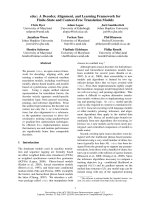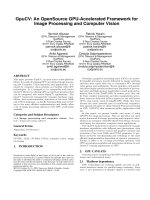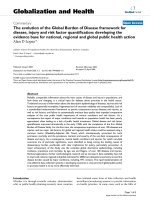Framework for project preparation and appraisal
Bạn đang xem bản rút gọn của tài liệu. Xem và tải ngay bản đầy đủ của tài liệu tại đây (796.06 KB, 43 trang )
Overall Framework
for Project Preparation and Appraisal
Saeed Ahmed Rana
ADFD/WB Project Preparation and Appraisal Workshop Abu Dhabi, April 2010
Why A Project?
This is an instrument to provide assistance to the billions in the developing world, who
need to overcome poverty and raise their standards of living.
Investment projects contribute to the sustainable socio-economic development of member
countries.
Such investment helps borrowers make the best use of their resources – natural, financial
and human – to alleviate poverty, protect the environment and enhance effectiveness of
public and private sectors.
2
Why project preparation and appraisal?
Project preparation and appraisal processes play an important role in enhancing the
developmental impact of investments and building government capacity in national
planning and investment.
These processes are not intended to be document driven but to bring together multiple
perspectives on a project and various tools of analysis needed to assess, monitor and improve
on the different activities and expenditure components involved in the project.
A strong foundation of preparation and appraisal can ensure better performance and
disbursement during the life of the project and is the primary framework for conducting project
supervision and monitoring.
3
A Framework for Project Preparation
and Appraisal
I.
Project Cycle
II. Project Rationale and Preparation
III. Borrower Roles
IV. Donor Roles
V. Project Appraisal
Costing Analysis
Environmental and Social Assessments
VI. Assessing Project Quality
VII. Early Signs of Project Failure
4
The Bank Project Cycle
Project Cycle - The project cycle starts with a development strategy based on
selectivity and comparative advantage.
It is targeted to country’s development objectives. It is followed by:
Identification
Preparation
Appraisal
Negotiations and Approval
Implementation and Supervision
Completion and
Evaluation
5
Stages of the Bank’s Project Cycle (I)
Country Assistance Strategy-the Bank proposes lending and advisory services to help countries
identify their priorities and reach their main development goals.
Identification-Projects are identified that support country strategies and that are financially,
economically, socially and environmentally sound.
Preparation-The Bank provides policy and project advice along with financial assistance. Clients
conduct studies and prepare final project documentation.
Appraisal-The Bank appraises the economic, technical, institutional, financial, environmental and
social aspects of the project. The project appraisal document and draft legal agreements are
prepared.
6
Stages of the Bank’s Project Cycle (II)
Negotiation and Board Approval-The Bank and Borrower agree on loan or credit agreement and the
project is presented to the Board for approval.
Implementation and Supervision-The Borrower implements the project. The Bank ensures that the
loan proceeds are used for the loan purposes with due regard for economy, efficiency and
effectiveness.
Implementation and Completion-The Bank team evaluates the performance of both the Bank and
Borrower.
Evaluation-The Bank’s Independent Operations Evaluation Department prepares an audit report and
evaluates the project. Analysis is used for future project design.
7
Project/Lending Types
Development Projects can be original projects, pilot projects or repeater projects
Pilot projects test the design criteria and implementation strategy of new technologies before embarking upon a full scale investment.
Repeater projects adopt the design and practices of a successful project for the same Project Development Objective (PDO) under
similar implementation conditions and environments.
A SWAp is a sectorwide approach that supports locally owned programs for a particular sector in a comprehensive and coordinated
manner.
SWAps promote increasing reliance on country systems and procedures and use a common framework for planning, implementation, expenditure,
and monitoring and evaluation
Project Lending is primarily the Specific Investment type Loan (SIL). Lending is also extended for sector investment, maintenance,
financial-intermediary and technical assistance projects.
8
Project Identification
Birth of a Project
Country Development Plans
Borrower Specific Request
Unforeseen Conditions (e.g.
natural calamities)
Set Project Development Objectives
Basic Consideration:
If the project is successful, what will be its principal outcome for the primary target group?
General Guidelines (see next slide)
9
Project Development Objective Guidelines
What group is targeted directly by the project as the key recipient of project benefits?
Immediately after the close of the project what problem would have been solved for the target group?
What will the target group be doing differently after the project that should make it better off?
The PDO should focus on the outcome for which the project reasonably can be held accountable, given the project duration, resources
and the approach.
The PDO should not merely restate the project’s components or outputs. Efficient use of inputs or delivery of outputs must be translated
into outcomes or results for the primary target group.
KISS Your PDO (Keep – It – Short - and - Simple), concise and meaningful.
Don’t try to reach the sky in one go.
PDO should not encompass higher level objectives that depend on other efforts beyond the scope of the project.
10
Strategic Areas of Focus for the Bank
Achieving results on the ground
Country capacity building
Measuring and reporting on results
Enabling environment
Beneficiary participation/ownership
Communication/messaging on results
Gender balance
Harmonization with MDBs
11
Bank’s Communication/Messaging on Results
Realistic DOs, Strategy, Quality,Risk
RX Frameworks,
Mgmt, RX based
Implementation
instruments
Realistic DOs, Strategy, Quality,Risk
RX Frameworks,
Mgmt, RX based
Implementation
instruments
•
Senior Management
attention
•
•
Recognition
Tools, IT systems,
RX Platform, CPRT
•
•
Harmonization with MDBs/Donors
12
Training, KL
Resources
Project Preparation - Borrower Role
Review identification and results
Initiate project preparation
Identify/set institutional framework
Determine need for TA
Set up project preparation office
Appoint project consultants
Inter-agency/departmental coordination
Prepare a Project Information Paper (PInfP)
Approach donors
13
Project Preparation - Donor Role
Assign project preparation team
Review borrower progress in project identification/preparation
Identify shortcomings and suggest actions to complete
Review alternative designs and justification for the selected design
Prepare Interim Information document (PID) based on PinfP
Set up peer reviewers
Review consultant’s progress and propose strengthening, if needed
Discussions
Borrower
Stakeholders
Potential donors
14
Sustainability Considerations At Preparation
Post project needs
Follow-up to sustain benefits
Institutional arrangements
Implementation
Follow up
Budget for O&M (Operation and Maintenance)
Beneficiary participation
Are beneficiaries identified?
Are they organized?
Are they willing to participate in project activities? [Participation is important to ensure
ownership and sustainability.]
Any NGO participation?
15
Project Preparation
Update Project Information Document (PID)
Field visit to assess preparation progress
technical, economic, environment, social studies
Completion of feasibility studies
Discussions with probable/potential co-financiers
Prepare Project Implementation Plan (PIP)
Project components
Implementation plan
Monitoring and Evaluation (M&E) Arrangements
Prepare Project Operation Plan (POP)
Guidelines
Arrangements for effective project operation
Risk analysis and mitigation measures
Performance Indicators PI. (see next slide)
16
Performance Indicators and Guidelines
Fewer is better. Identify a limited set of indicators for the Project Development Objective
both qualitative and quantitative
However, make sure that the selected indicators measure all PDO dimensions
Indicators should be S-M-A-R-T
S
M
A
R
T
Specific
Measurable
Attributable
Realistic
Targeted
17
(PDO)–
The Project Concept Note (PCN)
Draft and Circulate Project Concept Note
[PCN] *hyperlink
Three to four page document
It focuses on project concept, not design
It is prepared soon after project identification before project preparation costs become substantial
Functions
Examine the strategic rationale for Bank involvement
Promote consideration of alternative project concepts
Seek a go/no-go decision from the Country Director
Obtain early guidance/agreement on issues and approaches
Flag risks and potential mitigation measures
Seek early guidance on potential safeguard issues, consultation and disclosure
Agree on a resourced estimate, schedule and team [See PCN Template 1]
18
Sample PCN Cover Sheet
19
Preparation Completed
Quality Enhancement Review (QER)
Consistency of design with approved project concept
Quality assurance of the technical aspects of the project
Establish fiduciary (Financial Management and Procurement) requirements that need to be met by
appraisal
Review safeguards needed and specify project’s environmental and safeguard classifications and the
requirements to be met by appraisal.
Review project feasibility and sustainability aspects.
Propose actions to update PCN
At Preparation stage all technical economic financial institutional social environmental M&E O&M aspects
must be fully analyzed with viable options presented
PCN review
Discussion at management Level
Follow up on PCN review and finalize PCN
Obtain management’s authorization for project appraisal.
20
Project Appraisal
Project Appraisal is the process of assessing, in a structured way, the case for
proceeding with a project or proposal. It involves comparing various options,
based on economic and financial viability, technical feasibility and social and
environmental consideration/justification
Pre-Mission Actions
Finalize appraisal arrangements
Assign appraisal mission members
Ensure all subject matter specialists are included
Preferably Bank regular staff – consultants only in specialized areas
Ensure staff continuity until mission accomplished
Draft Project Appraisal Document
21
Pre-Mission Actions
Critical elements of PAD are:
Country background
Sector background
Project Development Objectives (PDO) Project Design (Tech. Institutional, Financial, Social,
Environmental, Procurement, M&E)
Project cost and financing
Project analysis (economic, financial)
Implementation arrangements (PIM, Institutional etc.)
Sustainability consideration
22
PAD Cover Sheet (1)
23
PAD Cover Sheet (2)
24
Pre-Mission Actions (Contd.)
Prepare issues paper
Explain unresolved issues and proposed solutions
Hold decision meeting
Seek managerial guidance on unresolved issues
[Note: Above two steps may be combined with activities under PCN Review]
Finalize appraisal arrangements with the government, borrower and cofinanciers, if any.
Prepare mission TOR
25









